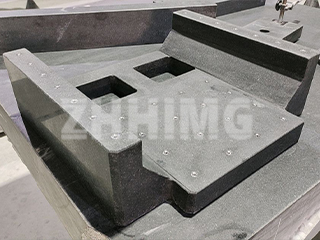Granite platforms are vital tools in precision measurement and testing across various industries. However, like any highly accurate tool, they can experience errors due to several factors during production and use. These errors, including geometric deviations and tolerance limits, can impact the platform’s precision. Properly adjusting and leveling your granite platform is essential for maintaining optimal performance and accuracy.
Common Errors in Granite Platforms
Errors in granite platforms can arise from two primary sources:
-
Manufacturing Errors: These can include dimensional errors, macro-geometric shape errors, positional errors, and surface roughness. These errors may occur during the fabrication process and can affect the flatness and overall accuracy of the platform.
-
Tolerance: Tolerance refers to the allowable deviation from the intended dimensions. It is the permissible variation in the actual parameters of the granite platform as determined by the design specifications.
While manufacturing errors are inherent in the production process, tolerance limits are predefined by designers to ensure the platform meets required performance standards. Understanding these errors and making necessary adjustments is crucial to maintaining the platform’s accuracy.
Steps for Adjusting Granite Platforms
Before using a granite platform, it’s crucial to adjust and level it properly. Below are the essential steps to follow when adjusting your granite platform:
-
Initial Placement
Place the granite platform flat on the ground. Ensure all four corners are stable, making minor adjustments to the support feet until the platform feels steady and balanced. -
Positioning on Supports
Place the platform on its support frame and adjust the support points to achieve symmetry. The support points should be placed as close to the center as possible for better balance. -
Initial Adjustment of Support Feet
Adjust the platform’s support feet to ensure even distribution of weight across all support points. This will help in stabilizing the platform and preventing any uneven pressure during use. -
Leveling the Platform
Use a leveling instrument, such as a spirit level or an electronic level, to check the horizontal alignment of the platform. Make fine adjustments to the support points until the platform is perfectly level. -
Stabilization Period
After the initial adjustment, allow the granite platform to settle for at least 12 hours. During this time, the platform should be left undisturbed to stabilize in its final position. After this period, check the leveling again. If the platform is still not level, repeat the adjustment process. Only proceed with usage once the platform meets the desired specifications. -
Periodic Maintenance and Adjustment
After the initial setup and adjustments, periodic maintenance and inspection are essential to ensure the platform continues to function optimally. Regular checks and adjustments should be made based on environmental factors such as temperature, humidity, and usage frequency.
Conclusion: Ensuring Accuracy Through Proper Adjustment and Maintenance
Proper installation and adjustment of granite platforms are critical for maintaining the accuracy and performance of precision measurement tasks. By following these simple steps, you can ensure that your granite platform stays accurate over time, helping you achieve the highest standards in industrial measurement.
If you need high-quality granite platforms or require assistance with setup and maintenance, contact us today. Our team offers precision solutions and expert services to ensure your granite platform performs at its best.
Post time: Aug-07-2025

